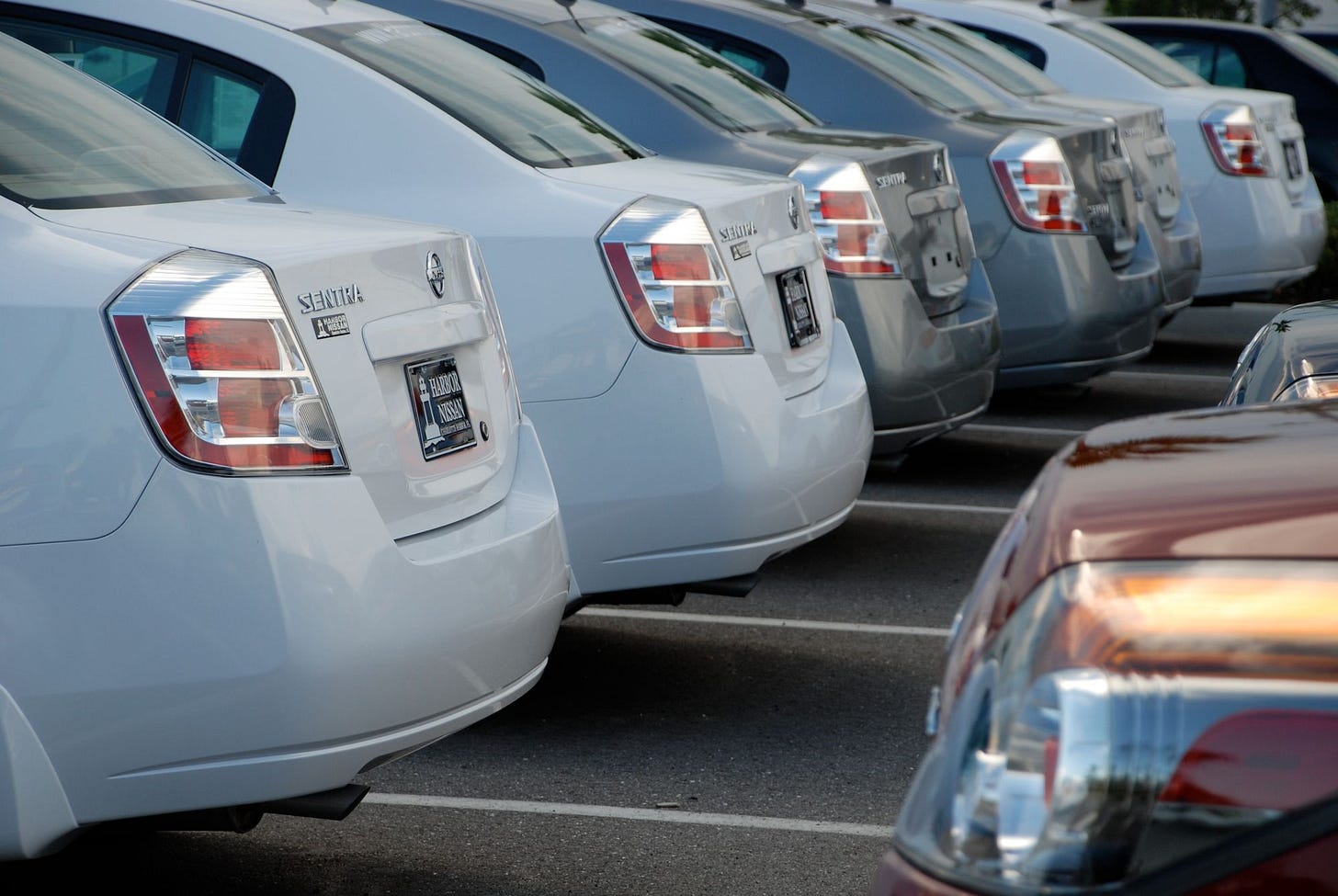How I reluctantly became an inflation crank
Inflation quality adjustments were always tricky. COVID-19 broke them.

This summer I stayed at a hotel from a well-known brand in an upscale suburb. The breakfast was comically unimpressive: little more than some individual cereal boxes, a limited assortment of poorly-cooled beverages, and paper dishware. And I could tell that it hadn’t always been that way: the room was large and had obviously been designed to host a more impressive spread in the days before COVID-19.
This put me into thought. Not self-pity—the Raisin Bran was fine, and I was happy to cut the hotel some slack. No, I was thinking about how economists measure production, and how these pandemic-induced degradations in quality are likely not fully reflected in our economic statistics.
Agencies like the Bureau of Labor Statistics (BLS) try to adjust for quality when they compute the inflation rate. And then they use this inflation rate to compute “real” measures like GDP and productivity. So if the official inflation rate is wrong, those other statistics will be off too.
But the government’s ability to adjust for quality is inherently limited. Statistical agencies have a limited budget, a limited set of objective measurements, and limited understanding of consumer preferences across time.
In normal times, this introduces a small pessimistic bias: the statisticians miss some quality improvements, and as a result, official figures tend to overstate the rate of inflation and underestimate how much living standards are rising. But over the last 18 months, we’ve had the opposite problem: goods and services are getting worse faster than the official statistics acknowledge, suggesting that our inflation problem has actually been bigger than the official statistics suggest.
A lot of responsible economists would hesitate to write this piece. I certainly did. Inflation commentary tends to bring out a deeply conspiratorial and pessimistic mindset. Some people believe the government has been dramatically under-stating the true inflation rate for decades. That’s not my view and I don’t want to give those folks any encouragement. But an accurate understanding of the economy is an essential precondition for good policymaking, and I would not rest too much of my worldview on inflation figures, or inflation-adjusted (“real") figures, from 2020 or 2021.
I was also wary of the policy implications. Some may point to falling quality as higher inflation, and therefore, a reason to tighten fiscal and monetary policy. That would be a mistake. In economics jargon, we shouldn’t reach for demand-side solutions to deal with supply-side problems. A lot of COVID-related quality degradations will naturally reverse themselves as the pandemic abates. The priority of policymakers should be to make sure consumers continue to have plenty of spending power when that happens.
Evidence of lower quality is widespread
My breakfast was not an isolated event; you can find examples of worsening quality across the economy.
Sometimes things are understandably worse as a direct consequence of COVID-19. For example, parents have frequently and unexpectedly lost daycare services when an outbreak occurs and the daycare shuts down. At a health clinic, I was asked to wait outside on the street, rather than in the waiting room, to minimize COVID-19 risks
Sometimes, product degradation comes with a plausible COVID-19 justification but also conveniently cuts labor costs. For example, hotels clean rooms less frequently on multi-night stays, which may limit contagion between housekeeping and guests, but also makes for a worse customer experience.
Sometimes, problems are clearly downstream of pandemic difficulties, but have no obvious consumer welfare justification: shipping delays are longer, and phone hold times at airlines are worse, a fact acknowledged by Delta CEO Ed Bastian.
I do not mean to criticize firms that have cut back or blame workers who haven’t returned. We know that firms are struggling to fill open positions. Some product issues may be downstream from that, and firms may be doing the best they can. But some pre-2020 product quality has clearly been lost, and those losses aren’t always reflected in the official data.
Our economic statistics under-adjust for quality

When a new product replaces an old one, changes in price might reflect quality differences rather than customers getting more or less for their money. Therefore, agencies like the BLS need quality adjustments to calculate the true rate of inflation. This is trickier than it sounds.
For example, a BLS primer on a method for computing auto price inflation includes a stylized example comparing 2013 and 2014 versions of the same car model. The 2014 model adds a backup camera worth $120 while removing an outdated 6-CD player valued at $30. Adjustments like this produce a target for what the 2014 model “should” cost relative to the 2013 one. If the actual price is higher than that, you have inflation. If it’s lower, you have deflation.
Cars are, however, the easy example. There aren’t very many car models, and their features are clearly defined and well-documented. Often their performance can be quantified using objective units like horsepower.
Now consider the market for hair care services. There are thousands of places to get a haircut. Some places have nicer furnishings than others, some workers are more talented than others, and a variety of extras might be included for free—or not.
To systematically adjust for haircut quality, BLS might have to send out thousands of employees to salons around the country—a preposterously expensive project. Even if it did that, it’s not obvious how to objectively measure whether one establishment delivered a more enjoyable experience or a more stylish result than another.
The problem is so difficult that the BLS doesn’t even try to solve it. Haircuts are one of many product categories that are simply not adjusted for quality. Even among those products that do get quality adjustments, thousands or millions of improvements slip under the radar each year.
One broad summary of these issues is the Boskin Report, a book-length study of inflation measurement commissioned by the Senate Finance Committee in the 1990s. In chapter five, the commission argued that the BLS wasn’t fully accounting for quality improvements, leading to a small but consistent overstatement of the inflation rate.
Now we’re likely facing the same problem, but in the opposite direction: many products are getting worse as a result of the pandemic. But the BLS doesn’t have the manpower—or in some cases even the conceptual framework—to fully capture all of these changes in its inflation measurements.
What if used cars aren’t much of an outlier?

The price of used cars today is more than 40 percent higher than it was a year ago. There is a very simple story for this inflation: demand for cars remains high, but the supply of new cars has been constricted by an acute shortage of the computer chips used in the electronic systems.
This is clearly an outlier in the data, a fact the White House, eager to combat bad news, has highlighted. They have also constructed inflation data removing cars and other outliers.
This approach gives me pause. As we saw above, cars are one of the easiest products to value objectively. The same properties that make it easy to measure auto quality in normal times make it obvious what kinds of strains the market is facing in these difficult times.
By contrast, changes elsewhere—even just in new cars—might be a bit more subtle. Cars.com notes that used car prices are approaching new car prices, contrary to decades of conventional wisdom about lightly-used cars being a great bargain. So why are new car prices not rising just as much? The article offers a hint: “the pricing trends listed above could tempt used-car shoppers to look for a new vehicle instead, but finding that exact vehicle in supply will likely be a challenge.” In other words, you might have to sacrifice on convenience or options, or you might not even get the car at all for months. These more subtle declines in the new-car customer experience are not picked up by inflation metrics.
So cars might not be that much of an outlier. Yes, they are struggling with pandemic conditions, but so is everyone else. Yes, it’s hard to get good value for your money, but that’s true elsewhere as well.
The big difference is automobile quality is easier to measure and harder to fudge. A hotel can make its breakfast spread less fancy without formal recognition that the product has changed. But a used car seller can’t promise a 2018 Toyota Camry and deliver a 2011 model.
There is no COVID productivity miracle
It is helpful to take today’s inflation numbers with a grain of salt because it makes the rest of the data—the figures that are adjusted for inflation—a bit easier to explain. For example, the Bureau of Economic Analysis (BEA) estimates that the economy has grown larger than ever before, and we are consuming more and better goods and services than ever. BEA data shows real GDP per capita—that is, output adjusted for inflation and population growth—is at an all-time high.
I certainly don’t feel that the second quarter of 2021 was our most prosperous or productive quarter. When it comes to overall welfare as a consumer, I would take the economic circumstances of 2019—and its ostensibly smaller consumption bundle—without second thought. I bet you would too.
If the official statistics miss quality changes and therefore understate recent inflation, then using those statistics for inflation adjustment will lead us to overstate progress in measures like real GDP per capita or real consumption per capita.
This insight also casts doubt on the idea of a COVID productivity boom, discussed recently by both the New York Times’ Neil Irwin and the Wall Street Journal’s Greg Ip. If GDP is up, even though we have many fewer people working before, then we must necessarily have become more productive.
Ip argues that this is a story about the pandemic accelerating technological adoption and forcing out unproductive old habits. Certainly, consulting and finance professionals who were previously required to fly to in-person meetings rather than hop onto a Zoom meeting might see it that way. Irwin includes the technology argument in his piece, but he also includes this paragraph:
Sometimes there are tricky measurement questions. For example, if a hotel charges the same prices but, with fewer housekeepers on the payroll, no longer provides a daily cleaning service, that arguably is a worsening in the quality of the product and therefore a form of inflation, rather than higher labor productivity.
Irwin presents this as a caveat to an otherwise positive situation. But what if it’s actually the bulk of the explanation?
Consider, for example, the reduction in college quality. If you look at the Oberlin College Fall 2020 Reopening FAQ, you get a sense of how much the product quality degraded due to COVID-19. Some students (juniors) would be off-campus to de-densify the campus. Courses would be a confusing mix of remote, hybrid, and in-person learning. The college assured students they’d figure out how to make this work for lab classes in the sciences. But overall, it went as you’d expect: not great. The students forced off campus found this miserable, isolating, and boring.
The FAQ did have a flair for the comedic, though. Its final section is a series of questions about whether students will receive any discounts for remote learning or lost amenities. The answer is always “no.”
Of course this took fewer workers to run, but it only did so by slashing features from the product. The CPI component this corresponds to—College Tuition and Fixed Fees—is not adjusted for product quality.
Tight macroeconomic policy isn’t the answer
One reason I was hesitant to deploy this line of logic is that it might convince people that the government should employ contractionary policy like Federal Reserve rate hikes, or tax increases, or spending cuts, in order to combat high inflation.
The problem with this line of reasoning is that this is supply-side inflation, and the government should not use demand-side policy on supply-side inflation. As the Boston Fed’s Eric Rosengren put it, in response to a different supply-side inflation bout:
Because my analysis suggests that recent food and oil price increases have their roots in concerns about wheat harvests in Russia and oil production in Libya and the like, I do not believe that monetary policy is the appropriate tool to respond to these disruptions. While many observers see food and energy prices rising and assume the Fed should tighten policy - raise the cost of money and credit - to head off inflation, I would suggest taking a step back and recognizing that tighter U.S. monetary policy will do nothing to stabilize Libyan oil production, reduce uncertainty about political stability in the rest of the Middle East, or increase the wheat harvest in Russia.
COVID-19 has created a similar outcome, just with different supply-side bottlenecks. Contractionary policy would not help to solve these problems. Contractionary policy is, roughly speaking, what you do when Congress and the Fed have released too much money into the economy: you tighten up the money supply. The inflation problem described has very little to do with loose money problems.
But politics tends to lack nuance, and talking up inflation tends to create pressure for contractionary policy. I hope this piece won’t.


